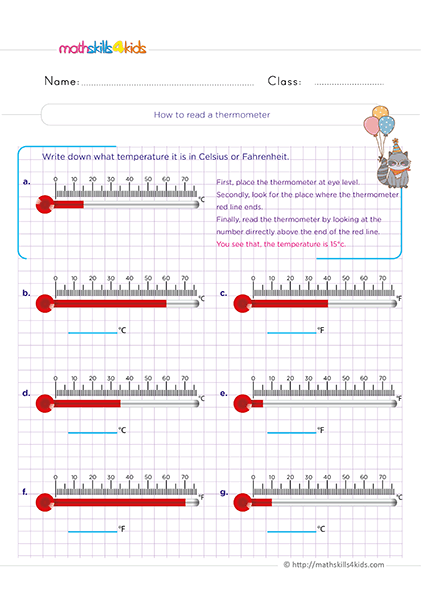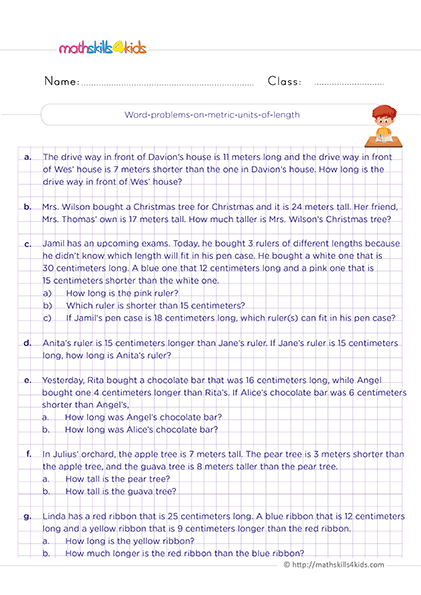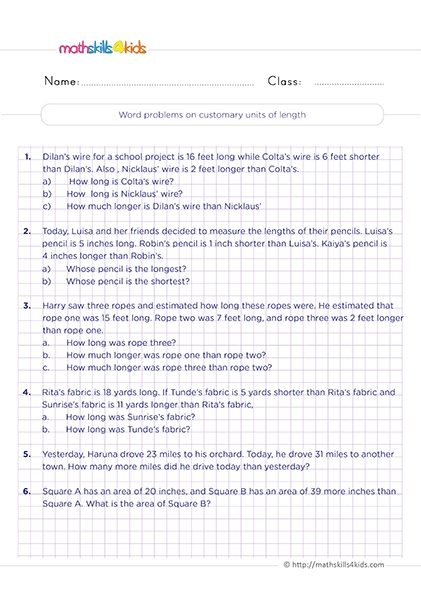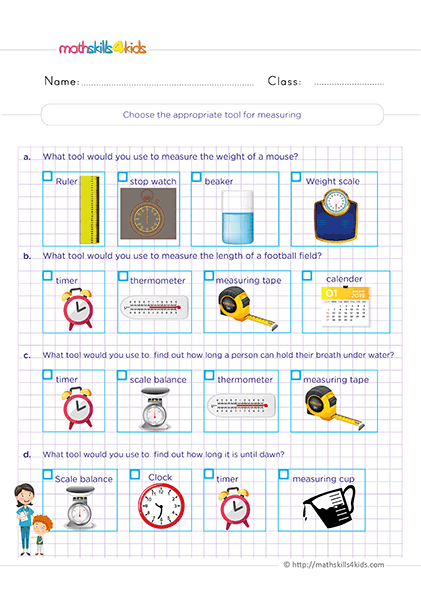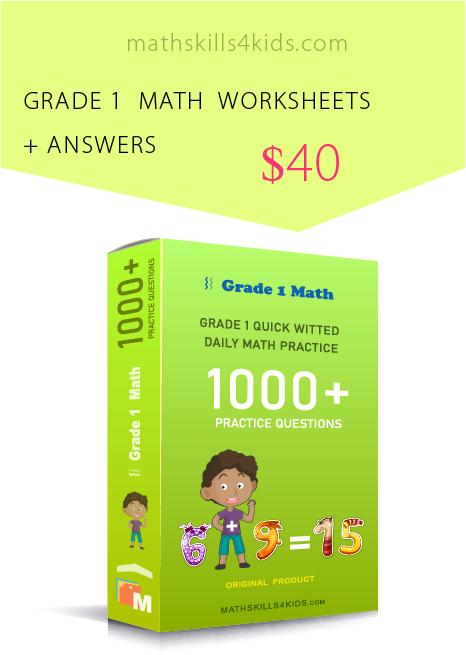2nd Grade units measurement worksheets: Printable and free
Hi there, and welcome to our thrilling article on measurement! If you're looking for fun and engaging ways to help your child learn about measurement, you've come to the right place. In this article, we will introduce you to MathSkills4Kids.com, a premium and enriching website offering a variety of fun, Printable, and free 2nd Grade units measurement worksheets.
These worksheets cover various topics related to measurement, such as length, width, height, size, weight, time, and more.
We'll also give you some tips and ideas on how to introduce measurement to your child in a fun and meaningful way and how to use everyday objects to practice measuring skills.
So let's get started!
-
Why measurement matters: A fun introduction
There are so many reasons why measurement matters to young math learners. Let's find out some:
First, measurement is an important skill that helps us understand the world. Secondly, we use measurement to compare and describe, plan and design things, follow directions and recipes, and solve problems.
Also, measurement helps us develop other math skills, such as number sense, geometry, fractions, and algebra. But measurement is not just about numbers and formulas. It's also about exploring and discovering things using our senses and curiosity.
That's why it's important to introduce measurement to your child in a fun and interactive way that sparks their interest and imagination.
One way to do that is to use stories and games that involve measurement. For example;
You can read books like "How Big Is a Foot?" by Rolf Myller or "Measuring Penny" by Loreen Leedy that show how different people or animals measure things differently.
You can also play games like "I Spy" or "20 Questions" that challenge your child to describe things using measurement words like big, small, short, heavy, light, etc.
You can also use songs and rhymes involving measurement, such as "Five Little Monkeys Jumping on the Bed" or "Ten in the Bed," to help your child practice counting and sequencing.
Another way to introduce measurement to your child is to use everyday objects they are familiar with and interested in. For example;
You can use toys, books, clothes, shoes, food items, etc., to measure things around the house or outside. You can also use your body parts, such as your hand, foot, arm, leg, etc., to measure things.
This way, your child will learn that measurement is not something abstract or boring but something that relates to their own life and experience.
-
BROWSE THE WEBSITE
-
DOWNLOAD FREE WORKSHEETS
-
-
2nd GRADE MATH TOPICS
- Counting and numbers
- Comparing and ordering
- Reading and writing numbers
- Shape patterns
- Adding of 1-digit numbers
- Subtracting of 1-digit numbers
- Additing 2-digit numbers
- Subtracting within 2-digits
- Up to 3-digit addition
- Subtracting within 3-digit
- Properties of addition & subtaction
- Mixed operations
- Place-value
- Estimating and rounding
- Logical reasoning
- Money Math
- Telling Time
- Data and graphing
- Units of measurement
- 2D shapes
- 3D shapes
- Geometric measurement
- Fractions
- Probability
- Multiplication
- Division
-
-
-
How to measure length, width, and height with everyday objects
One of the first concepts of measurement that your child will learn is how to measure the length, width, and height of objects.
- Length is how long something is from one end to another.
- Width is how wide something is from side to side.
- Height is how tall something is from bottom to top.
To measure these dimensions of objects, we need a unit of measurement that is consistent and standard. For example, we can use a ruler or a tape measure with markings of inches or centimeters.
But before your child learns how to use these tools, they need to understand the idea of using a unit of measurement that is equal in size. For example, they need to know that if they use their hand as a unit of measurement, they have to use the same hand every time they measure something.
They also need to know that they have to align the unit of measurement with the object they are measuring without leaving any gaps or overlaps.
To help your child practice these skills, you can use everyday objects as units of measurement. For example,
- You can use paper clips or pencils to measure the length of a book or a table.
- You can use coins or buttons to measure the width of a window or a door.
- You can use blocks or books to measure the height of a chair or a shelf.
- You can use your hand or foot to measure the length of a couch or a bed.
- You can use your finger or thumb to measure the width of a picture frame or remote control.
- You can use your head or arm to measure the height of a lamp or a plant.
As you measure different objects with different units of measurement,
- Ask your child questions like "How many paper clips/pencils/coins/buttons/blocks/books/hands/feet/fingers/thumbs/heads/arms do you need to measure this object?"
- Encourage your child to count aloud as they place the units of measurement along the object.
- Compare the results with different units of measurement and ask your child which one gives a bigger or smaller number.
- Explain that different units of measurement give different numbers because they are different in size.
- Introduce the idea of using standard units of measurement like inches or centimeters that are the same for everyone.
-
Comparing and ordering objects by size and weight
Another concept of measurement that your child will learn is how to compare and order objects by size and weight.
- Size is how big or small something is.
- Weight is how heavy or light something is.
To compare and order objects by size and weight, we need to use words like bigger, smaller, longer, shorter, wider, narrower, taller, shorter, heavier, lighter, etc.
We also need to use symbols like > (greater than), < (less than), or = (equal to) to show the relationship between two objects.
To help your child practice these skills, you can use everyday objects that are different in size and weight. For example,
- You can use fruits or vegetables to compare and order by size and weight. For example;
You can ask your child which one is bigger or smaller, heavier or lighter:
An apple or a banana, a carrot or a cucumber, a grape or a cherry, etc.
- You can use clothes or shoes to compare and order by size and weight. For example, you can ask your child which one is bigger or smaller, heavier or lighter:
A shirt or a sweater, a sock or a shoe, a hat or a scarf, etc.
- You can use toys or books to compare and order by size and weight. For example, you can ask your child which one is bigger or smaller, heavier or lighter:
A ball or a doll, a puzzle or a board game, a comic book or a dictionary, etc.
As you compare and order different objects by size and weight,
- Ask your child questions like "Which one is bigger/smaller/longer/shorter/wider/narrower/taller/shorter/heavier/lighter: this one or that one?"
- Encourage your child to use their hands or eyes to estimate the size or weight of the objects before measuring them.
- Use a balance scale or a kitchen scale to measure the weight of the objects and show your child the difference in grams or ounces.
- Use words and symbols like >, <, or = to write sentences that compare the objects. For example, "The apple is heavier than the banana. The apple > the banana."
- Explain that comparing and ordering objects by size and weight helps us sort and classify things into groups or categories.
-
Exploring units of measurement: Inches, feet, yards, and miles
Apart from comparing and ordering objects by size and weight, our 2nd Grade units measurement worksheets also offer practice in exploring different units of measuring length and distance.
Length and distance are how far something is from one point to another.
To measure length and distance, we need to use units appropriate for the object’s size or the space we are measuring. For example,
- We can use inches to measure small objects like a pencil or a paper clip.
- We can use feet to measure medium-sized objects like books or tables.
- We can use yards to measure large objects like a couch or a car.
- We can use miles to measure vast distances, like from one city to another.
To help your child practice these skills, you can use everyday objects and spaces that are different in length and distance. For example,
- You can use a ruler or a tape measure with markings of inches, feet, yards, and miles to measure different objects around the house or outside.
For example, you can measure the length of your child's arm or leg in inches, the width of your living room or backyard in feet, the height of your house or a tree in yards, and the distance from your home to school or the park in miles.
- You can use paper strips cut into different lengths of inches, feet, yards, and miles to model different objects or spaces. For example,
- You can make a model of your child's arm using 12 paper strips, each 1 inch long, and tape them together end to end.
- You can make a model of your living room using 10 paper strips, each 1 foot long, and arrange them into a rectangle.
- You can make a model of your house by using 3 paper strips that are each 1 yard long and stack them on top of each other.
- You can make a model of the distance from your home to school by using 2 paper strips that are each 1 mile long and laying them side by side.
As you explore different units of measurement for length and distance:
- Ask your child, “How many inches/feet/yards/miles do you need to measure this object/space?"
- Encourage your child to count aloud as they place the ruler/tape measure/paper strips along the object/space.
- Compare the results with different units of measurement and ask your child which one gives a bigger or smaller number.
- Explain that different units of measurement give different numbers because they are different in size.
- Introduce the idea of converting between different units of measurement by using simple formulas.
-
Converting between different units of measurement
One of the most important skills in measurement is to convert between different units of measurement. For example:
- How many feet are in a yard?
- How many inches are in a mile?
- How many cups are in a gallon?
You will encounter these questions in everyday life and math problems.
-
Basic facts and rules to convert between different units of measurement
To convert between different units of measurement, you need to know some basic facts and rules. Here are some of them:
- There are 12 inches in a foot, 3 feet in a yard, and 1760 yards in a mile.
- There are 16 ounces in a pound and 2000 pounds in a ton.
- There are 8 fluid ounces in a cup, 2 cups in a pint, 2 pints in a quart, and 4 quarts in a gallon.
To convert from a smaller unit to a larger unit, you need to divide by the number of smaller units in one larger unit. For example, you need to divide by 12 to convert from inches to feet.
To convert from a larger unit to a smaller unit, you need to multiply by the number of smaller units in one larger unit. For example, you need to multiply by 3 to convert from yards to feet.
Here are some examples of how to convert between different units of measurement:
- How many feet are in 6 yards? To find out, we need to multiply 6 by 3 because there are 3 feet in a yard. The answer is 18 feet.
- How many inches are in 2 miles? To find out, we need to multiply 2 by 1760 because there are 1760 yards in a mile and then multiply by 12 because there are 12 inches in a foot. The answer is 42240 inches.
- How many cups are in 3 gallons? To find out, we need to multiply 3 by 4 because there are 4 quarts in a gallon and then multiply by 2 because there are 2 cups in a pint. The answer is 24 cups.
You can practice converting between different units of measurement using the worksheets from Mathskills4kids.com below. These printable Mathskills4kids’ printable 2nd Grade units of measurement worksheets will help you master this skill and prepare you for more challenging math problems.
-
Estimating and measuring time in seconds, minutes, and hours
Estimating and measuring time is another important aspect of measurement. We use time to measure how long something lasts or how often something happens. We use different units of time for different purposes. The most common units of time are seconds, minutes, and hours.
- A second is the smallest unit of time that we use. It is about as long as it takes to say "one Mississippi."
- A minute is made up of 60 seconds. It is about as long as it takes to sing "Happy Birthday."
- An hour is made up of 60 minutes. It is about as long as it takes to watch an episode of your favorite show.
To estimate and measure time, we use clocks and watches.
- A clock has two hands: a short hand that shows the hour and a long hand that shows the minute.
- A watch can have either hands or digits that show the hour and the minute. Some watches also show the second.
You need to know some basic facts and rules to read a clock or a watch. Here are some of them:
- The short hand points to the hour or the hour it is close to.
- The long hand points to the minute it is, or the minute it is close to.
- Each number on the clock or the watch represents 5 minutes.
- To find out the exact minute, count by fives from the number the long hand points to until you reach the top of the clock or the watch.
Then you need to count by ones from there until you reach the long hand.
- To determine if it is AM or PM, look at the sky or use other clues.
AM means before noon, and PM means after noon.
-
Solving word problems involving measurement
One of the most important skills that your 2nd grader will learn is applying their measurement knowledge to solve real-world problems.
Word problems are a great way to test their understanding and challenge their thinking. They also help them practice reading comprehension, math vocabulary, and logical reasoning.
Here are some tips to help your 2nd grader solve word problems involving measurement:
- Read the problem carefully and identify what is being asked. Is it about length, width, height, size, weight, or time?
- Look for keywords that indicate the unit of measurement, such as inch, foot, yard, mile, second, minute, hour, etc.
- Draw a picture or use manipulatives to visualize the problem and the given information.
- Write an equation or a number sentence that represents the problem. Use symbols like +, -, x, /, =, <, >, etc.
- Solve the equation or the number sentence using the appropriate operation and unit of measurement.
- Check your answer by plugging it into the equation or the number sentence. Does it make sense? Does it match the unit of measurement?
- Write your answer in a complete sentence using words and numbers.
Here are some examples of word problems involving measurement for 2nd grade:
- Anna has a ribbon that is 12 inches long. She cuts off 3 inches from one end and 4 inches from the other. How long is the remaining piece of ribbon?
- Ben is 48 inches tall. He wants to ride a roller coaster with a height requirement of 54 inches. How many more inches will he grow to ride the roller coaster?
- Claire has a book 8 inches wide and 10 inches long. She wants to cover it with wrapping paper 12 inches wide and 15 inches long. How much wrapping paper will she have left after covering the book?
- David ran a race that was 3 miles long. He ran the first mile in 10 minutes, the second in 12 minutes, and the third in 8 minutes. What was his average speed for the whole race?
- Emma baked a cake that weighed 2 pounds. She cut it into 8 equal pieces and gave 3 pieces to her friends. How much did each piece weigh? How much cake did she have left?
Review and practice: Measurement worksheets for 2nd grade
After learning about measurement and solving word problems, your 2nd grader will need some review and practice to reinforce their measurement skills and confidence.
Measurement worksheets are a great way to provide them with extra practice and feedback.
You can find many printable and free measurement worksheets for 2nd grade online. Some of them are:
- https://www.math-salamanders.com/2nd-grade-measurement-worksheets.html
- https://www.k5learning.com/free-math-worksheets/second-grade-2/measurement
- https://www.education.com/worksheets/second-grade/measurement/
- https://www.mathworksheets4kids.com/second-grade-measurement.php
These worksheets cover various topics and skills related to measurement, such as:
- Measuring length, width, height, and distance using rulers and tape measures
- Comparing and ordering objects by size and weight using words like longer, shorter, taller, heavier, lighter, etc.
- Exploring units of measurement such as inches, feet, yards, miles, centimeters, meters, kilometers, grams, kilograms, etc.
- Converting between different units of measurement using simple formulas and tables
- Estimating and measuring time using clocks and calendars
- Solving word problems involving measurement using addition, subtraction, multiplication, division, fractions, decimals, etc.
Print these worksheets as homework assignments or extra practice for your 2nd grader. You can also check their answers using the answer keys provided on the websites.
Thank you for sharing the links of MathSkills4Kids.com with your loved ones. Your choice is greatly appreciated.
-
Measurement is an essential skill that your 2nd grader will use in many aspects of their life. They will develop their math, science, and problem-solving abilities by learning about measurement and practicing it with worksheets and activities.
We hope you enjoyed this article about 2nd Grade units measurement worksheets: printable and free.
If you have any questions or comments, please leave them below. Also, don’t hesitate to visit our website, Mathskills4kids.com, for more educational and enriching math activities for all grades and topics.
Thank you for reading!
